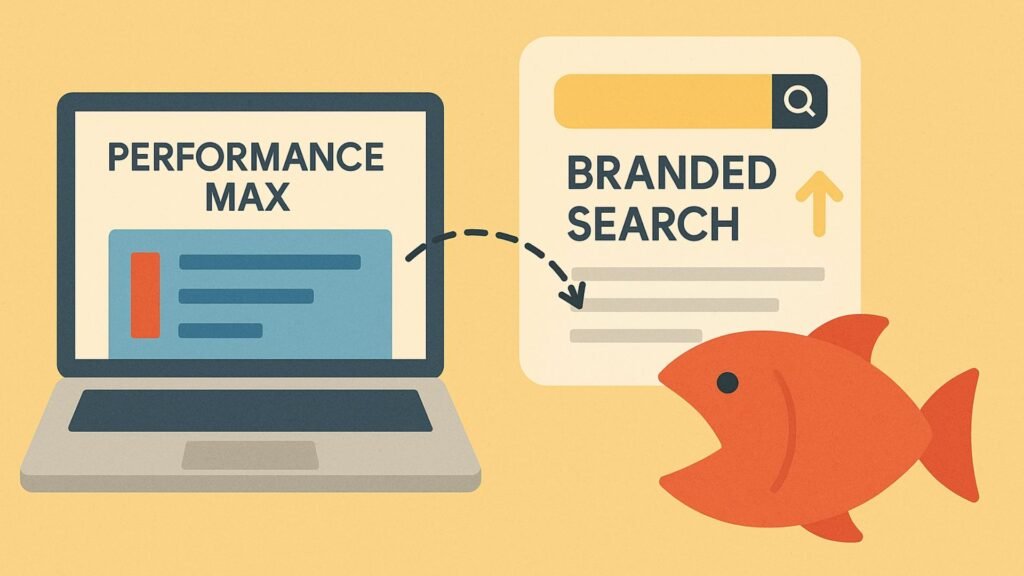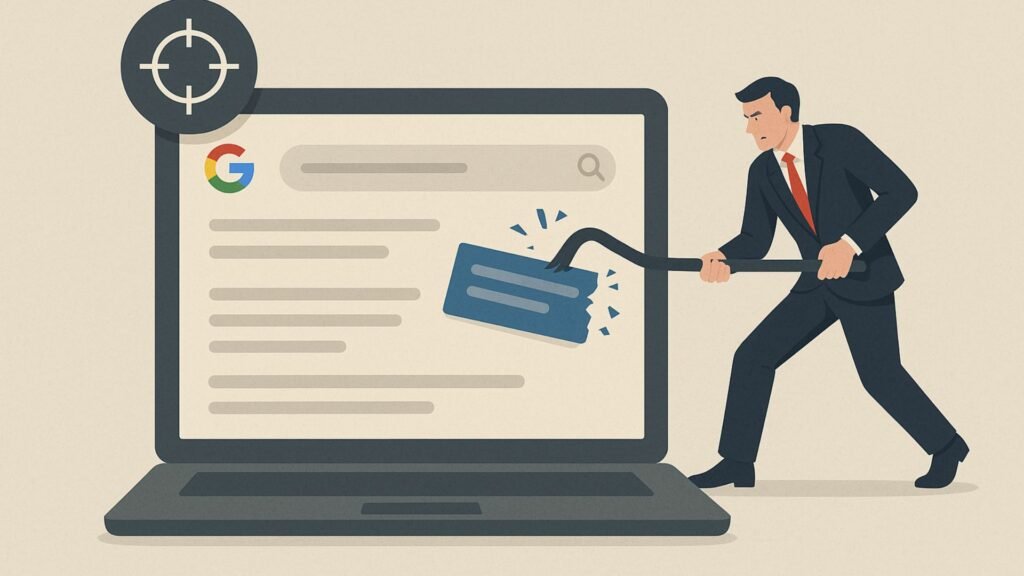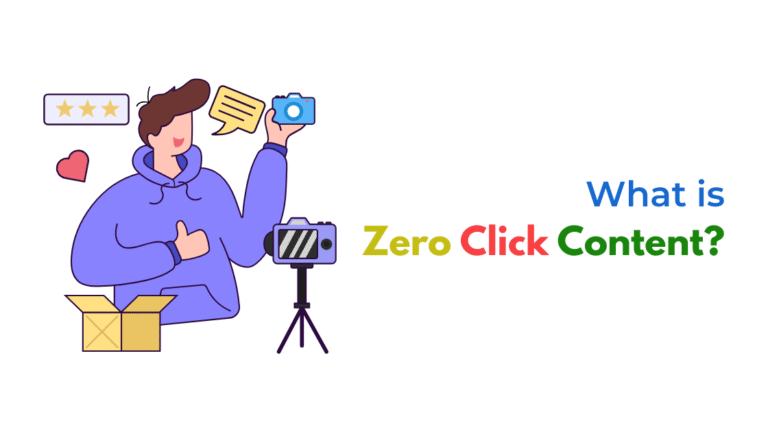Performance Max campaigns can cannibalize branded search traffic because they automatically prioritize lowest-cost conversions, often overtaking your Search campaigns targeting branded keywords. Without exclusions or campaign structure controls, Google may shift brand traffic away from exact match branded campaigns to Performance Max.

If you’ve been running a Performance Max (PMax) campaign and noticed a drop in your branded search campaign performance, you’re likely facing cannibalization. This is when your PMax campaign starts intercepting traffic meant for your dedicated branded Search campaigns. The result? Higher costs, messy data, and reduced control over one of your most important assets—your brand.
Let’s break this down in a simple and actionable way.
What Is Branded Search Traffic and Why It Matters
Branded search traffic refers to people who search for your business name or closely related brand keywords—for example:
- “Socinova”
- “Socinova digital marketing services”
- “Socinova reviews”
This traffic is extremely valuable. These users already know who you are. They’re either returning customers, referrals, or people close to conversion.
Normally, you’d want this traffic handled by a branded Search campaign with tailored ad copy, extensions, and optimized landing pages. But with Performance Max in the mix, this clean structure can break down.
What Is Campaign Cannibalization?
Cannibalization in Google Ads means one campaign unintentionally takes traffic away from another. In this case, your PMax campaign starts showing ads for branded queries—even though your branded Search campaign already exists for those terms.
This results in:
- Unnecessary budget usage by PMax
- Higher CPCs
- Misleading conversion attribution
- Loss of messaging control
Why Performance Max Prioritizes Branded Queries
Here’s why PMax often takes over branded traffic:
1. Lowest-Cost Conversions Win
Performance Max is designed to find the cheapest conversions possible. Branded queries typically:
- Have high intent
- Convert well
- Cost less per click
So PMax naturally shifts budget and attention to these queries to meet its conversion goals.
2. Campaign Priority Rules Favor PMax
Google’s campaign priority hierarchy gives Performance Max priority over all campaign types, except:
- Exact match Search campaigns
- When the user query exactly matches the exact match keyword
If your branded campaign uses broad or phrase match, PMax will often win the impression.
3. Lack of Brand Keyword Exclusions by Default
Unless you explicitly exclude your brand from PMax, Google assumes it’s fair game. Most advertisers don’t realize this until after seeing their branded campaign performance drop.
4. Automation Has No Context
PMax uses AI to chase conversions. It doesn’t understand branding strategy. It only knows what’s working numerically. If your branded terms deliver results, they become a target—regardless of your campaign intent.
Signs Your Branded Traffic Is Being Cannibalized
If you’re unsure whether this is happening in your account, look for these indicators:
- Your branded Search campaign impressions or clicks have dropped
- Your branded CPCs have increased
- Your PMax campaign shows strong branded queries under “Search Term Insights”
- Overall conversions are up, but your brand Search performance is down
How to Check:
- Go to your PMax campaign in Google Ads
- Click Insights > Search Term Insights
- Look for any queries containing your brand name
Even though PMax offers limited visibility, this section can still give you important clues.
Real Consequences of Branded Traffic Cannibalization
This issue isn’t just about numbers—it can affect multiple areas of your performance and strategy:
1. Budget Misuse
PMax might start spending a large portion of your budget on people who were already going to click on your brand ad anyway.
2. Loss of Custom Messaging
Your branded Search campaign likely uses specific headlines, extensions, and URLs. PMax often uses auto-generated assets, which may not align with your brand messaging.
3. Inflated Performance Data
PMax may appear to be driving strong results when in reality it’s just taking credit for branded traffic that your Search campaign would have captured more efficiently.
4. Difficulty in Measuring Campaign ROI
You won’t be able to properly segment or measure new customer acquisition vs returning or branded queries. This can make scaling campaigns more difficult.
How to Stop PMax from Cannibalizing Branded Search Traffic
Let’s walk through effective and proven methods to protect your branded traffic.
1. Use Brand Exclusions in Performance Max
Google now allows you to explicitly exclude your brand keywords from Performance Max.
Steps to set this up:
- Go to your PMax campaign settings
- Scroll to the “Brand Exclusions” section
- Add all versions of your brand name and related keywords
- Example:
Socinova,Socinova marketing,Socinova social media
- Example:
- Save and monitor changes in your account performance
Resource: Google Ads Brand Exclusions Help Page
This is one of the most important steps to take immediately.
2. Create an Exact Match Branded Search Campaign
Google gives higher priority to Search campaigns with exact match keywords. This means you need to:
- Set up a Search campaign specifically for branded terms
- Use exact match syntax for all keywords
Example:
[socinova][socinova digital marketing]
[socinova pricing]
Avoid broad or phrase match if you want to maintain control.
3. Add Account-Level Negative Keywords (If Brand Exclusions Are Not Enough)
If brand exclusions don’t cover everything, consider using account-level negatives:
- Go to “Account Settings” in Google Ads
- Add negative keywords at the account level for branded terms
- This will apply across all campaigns, including Performance Max
This is useful when brand exclusions aren’t available in older or limited accounts.
4. Split Campaigns Based on Funnel Stage and Intent
Keep your branded traffic completely separate from:
- Top-of-funnel cold traffic
- Competitor traffic
- Retargeting audiences
Segment your campaigns like this:
- Branded Search campaign – exact match only
- PMax campaign for non-branded acquisition
- Display or YouTube for awareness and retargeting
This way, each campaign has a specific purpose and audience.
5. Narrow Down Your Audience Signals in PMax
Avoid using audience signals that heavily overlap with your existing branded audience. Use:
- Custom segments based on competitors or industry terms
- Lookalike audiences from CRM data (not past converters)
- Exclude your branded page visitors using Google Ads audience lists
6. Use a Data-Driven Attribution Model
Many advertisers use last-click attribution, which can falsely credit conversions to PMax when branded traffic was the real driver.
Switch to Data-Driven Attribution (DDA) in Google Ads to:
- Spread credit across multiple touchpoints
- Get a clearer picture of true campaign impact
- Reduce false credit assigned to PMax
7. Track Performance with Clear Reporting
Here’s how to keep an eye on cannibalization going forward:
- Regularly export and analyze Search Term Insights from PMax
- Compare branded clicks and impressions over time in your Search campaign
- Set up a custom report that shows performance split by branded and non-branded campaigns
Also, use GA4 to monitor how different campaigns contribute to conversions, especially for landing pages and campaign IDs.
When Might It Be Okay to Let PMax Handle Brand Traffic?

There are a few scenarios where you might allow it:
- You’re a brand-new business without established branded campaigns
- You want to test automation end-to-end
- Your goal is pure conversion volume without concern for data separation
However, for most established businesses, controlling branded traffic through Search is more effective and efficient.
The Right Way to Run PMax Without Losing Control
Checklist for avoiding branded traffic cannibalization:
- Add brand exclusions in PMax
- Build an exact match branded Search campaign
- Use account-level negative keywords if needed
- Segment campaign goals by funnel stage
- Limit audience signals in PMax
- Monitor Search Term Insights and campaign overlap
Additional Resources for Deep Dives
Final Thoughts
Performance Max can be a valuable tool—but only when used with strategic boundaries. Your branded traffic is too important to leave in the hands of AI. By setting exclusions, structuring campaigns smartly, and monitoring overlap, you protect your budget and keep your data clean.
Need Help Optimizing Google Ads?
At Socinova, we’ve helped dozens of clients restructure their Google Ads campaigns for maximum clarity, efficiency, and ROI. Whether it’s fixing cannibalization or scaling smartly with PMax, our team can help you take full control of your ad performance.
👉 Start a conversation today — no pressure, just smart advice.




